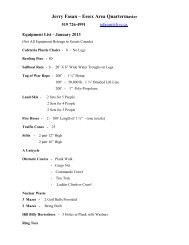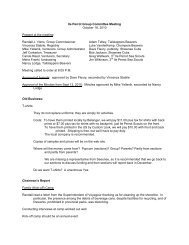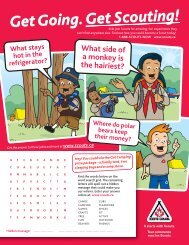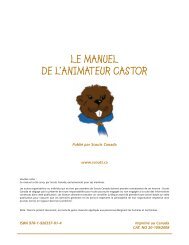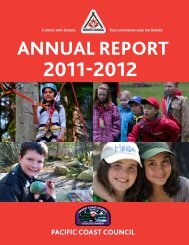Beaver Leader's Handbook - Scouts Canada
Beaver Leader's Handbook - Scouts Canada
Beaver Leader's Handbook - Scouts Canada
Create successful ePaper yourself
Turn your PDF publications into a flip-book with our unique Google optimized e-Paper software.
DETERMINATION OF TAIL COLOUR<br />
7-2<br />
When <strong>Beaver</strong>s join your section, fit them into tail groups under these guidelines:<br />
Typical Age Tail Colour<br />
5 years Brown<br />
6 years Blue<br />
7 years White<br />
Before Swim-up White with Magic Light symbol<br />
Generally, a five-year-old <strong>Beaver</strong> will wear a brown tail; a six-year-old will wear a blue tail; and<br />
a seven-year-old will wear a white tail. They remain in those tail groups for the Scouting year.<br />
In early fall, give a <strong>Beaver</strong> who is still five, but soon to be six, a blue tail so the child will be in<br />
the same tail group as peers who have already had their sixth birthday. Similarly, give a six-yearold<br />
(but soon to be 7) a white tail.<br />
Based on the needs of each <strong>Beaver</strong>, the colony leadership team has to decide what the word<br />
“soon” means in actual time. What’s the most important consideration? It’s the <strong>Beaver</strong>’s comfort<br />
level within the group – the child’s ability to feel a sense of belonging and accomplishment.<br />
Because <strong>Beaver</strong>-aged children show marked individual differences in their rate and degree of<br />
growth, you can’t expect all <strong>Beaver</strong>s with the same colour tails to interact and perform at the<br />
same level in all activities. But more <strong>Beaver</strong>s in a tail group will be at a similar developmental<br />
level than those in a lodge group where ages (and stages) range from five to seven years.<br />
Consider the ages suggested for these various tail colours as only guidelines. Be flexible. You<br />
may encounter an exception (e.g. a <strong>Beaver</strong> who is developmentally impaired for physical, mental<br />
or social reasons). In these exceptional cases, the leadership team, in cooperation with the<br />
parents, needs to determine where a child with certain abilities and a certain degree of maturity<br />
will be able to function most effectively.<br />
Make every effort to move each <strong>Beaver</strong> through the program and the three tail groupings. It’s<br />
important to ensure that every seven-year-old wears a white tail, and is ready to move to Cubs<br />
when eligible to join that section when the youth reaches eight years old.<br />
You can successfully use tail groupings for crafts, games, stories, outings, etc. Just vary the difficulty<br />
of the tasks to suit the stages of <strong>Beaver</strong> development and relative abilities.<br />
Tail groupings are most effective when used in partnership with lodge groupings. Lodges are<br />
similar to family units (children of different ages), and offer <strong>Beaver</strong>s opportunities for different<br />
kinds of interaction (e.g. older <strong>Beaver</strong>s helping younger ones, and younger <strong>Beaver</strong>s looking to<br />
older ones for leadership).<br />
PROGRAM USE OF TAILS<br />
Tails are an important way to show <strong>Beaver</strong>s they are growing and changing. Five, six and sevenyear-olds<br />
have some noticeably different needs (discussed in Chapter 6). Tail groups will help<br />
you plan a program in which all <strong>Beaver</strong>s can work at their respective levels of ability. You can<br />
apply tails to programs in several ways.



